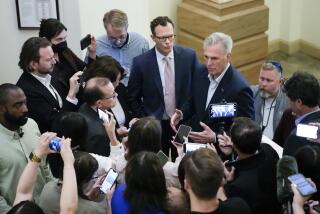4 Officials to Iron Out Snags in S&L; Rescue Plan
- Share via
WASHINGTON — Congressional negotiators, eager to finish their work on the massive savings and loan rescue package, decided Tuesday to allow a handful of House and Senate leaders to draft the detailed legislation.
The biggest disputed issues are the financing of the rescue package and the federal regulation of state-chartered S&Ls;, Senate Banking Committee Chairman Donald W. Riegle Jr. (D-Mich.) told the conference.
The future use of junk bonds as investments for S&Ls; also is in dispute. The Senate wants to permit their continued use but to reduce the maximum holding of the high-yield, high-risk bonds to 6% of an S&L;’s assets, compared to a limit of 11% now. The House would ban future junk bond purchases and would require the sale of current portfolios within two years, a step that could hit hard at some California financial institutions.
Eight Southern California thrifts own $7.3 billion in junk bonds, or 51% of the national total held by thrift institutions, according to a study issued Tuesday by Alex Sheshunoff & Co., an Austin, Tex., consulting firm.
The massive S&L; conference, which includes 94 House members and eight senators, adjourned temporarily on Tuesday, leaving the task of preparing a detailed compromise to a quartet composed of the Democratic chairmen of the two banking committees and the ranking Republican members of each.
With most issues resolved, the conferees agreed to wait until they get a plan from the closed-door sessions held by Riegle, Sen. Jake Garn (R-Utah), House Banking Committee Chairman Henry B. Gonzalez (D-Tex.) and Rep. Chalmers P. Wylie (R-Ohio).
“We ought to, over the next couple of days, get the legislative language worked out so that we have the basis of a single package,” said Riegle, who has been serving as chairman of the full conference.
“In the great bulk of the areas, we are quite close together,” he said in proposing the private drafting sessions.
The biggest issue blocking final agreement is the best way to raise $50 billion that will be used to close hundreds of S&Ls; by paying off depositors whose accounts are insured up to $100,000. The Senate and President Bush want the formation of a new agency to sell bonds, which would not be included in the budget deficit.
The House wants to raise the funds directly by the sale of Treasury bonds, which carry the lowest interest rate of any government securities. The outlays would be on the federal budget but would be exempted from the ceilings on spending in the Gramm-Rudman balanced budget law.
Both sides have agreed on the need for strict capital standards, requiring S&L; owners to furnish billions of dollars in additional cash to buttress their institutions. The general agreement on capital “was the single most important issue in the bill,” Wylie said.
In the junk bond study, S&L; consultant Sheshunoff said, “speculating in junk bonds with federally insured deposits has absolutely no relevance to financing home ownership in America--the basic premise of the thrift industry.”
The federal insurance for deposits “wasn’t created to provide a guaranteed method of raising low-cost speculative investment funds for thrifts,” he said.
Garn said he strongly opposes the House demand that S&Ls; get rid of their junk bonds. “I can’t find a single institution that has failed because of junk bonds,” the Utah senator said.
The other key unsettled regulatory issue centers on the federal oversight of state-chartered S&Ls;, now conducted by the Federal Home Loan Bank Board. The House wants the Federal Deposit Insurance Corp., regulator of banks, to perform the same role for thrifts. But the Senate wants the job done by the Office of Savings Assns., the successor to the bank board under the proposed legislation.
More to Read
Get the L.A. Times Politics newsletter
Deeply reported insights into legislation, politics and policy from Sacramento, Washington and beyond. In your inbox twice per week.
You may occasionally receive promotional content from the Los Angeles Times.









